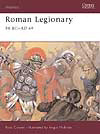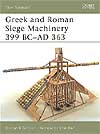 by Jennifer MacAire
by Jennifer MacAire
In Book 2 of McAires "Iskander" series, a time-traveling journalist continues her adventure with Alexander the Great in the exotic province of Bactria.
"A faint smell of smoke was in the air, but the streets were deserted. As we rode into the village, heads poked out of doorways. A couple skinny dogs barked. Then children appeared. Always the most curious, they slipped past their parents, standing uncertainly in the doorways, and ran to greet us. Shouting and clapping their hands, they gathered around the horses, touching them and us, patting our legs, asking the hundreds of questions children always asked. Our horses, used to war and confusion, didnt mind when the children grabbed at their tails and rich trappings. Alexander had gold tassels on his horses blanket, and braided into Bucephales tail were red and white silk ribbons. These fluttered in the breeze, making each of the horses movements a celebration."
 The period 31 BC-AD 43 saw the greatest expansion of the Roman Empire. In 31 BC Octavian defeated Antony at the battle of Actium and remodelled the semi-professional Roman army into a permanent force of 28 legions. Octavian became the first emperor (Augustus) and under his leadership the legions conquered northern Spain, all Europe south of the Danube line and Germany west of the Elbe. The legionaries exemplified the heroic culture of the Roman world and this title takes a behind-the-scenes look at their lives, training, weaponry and tactics, including the bloody massacre of the Teutoberg forest.
The period 31 BC-AD 43 saw the greatest expansion of the Roman Empire. In 31 BC Octavian defeated Antony at the battle of Actium and remodelled the semi-professional Roman army into a permanent force of 28 legions. Octavian became the first emperor (Augustus) and under his leadership the legions conquered northern Spain, all Europe south of the Danube line and Germany west of the Elbe. The legionaries exemplified the heroic culture of the Roman world and this title takes a behind-the-scenes look at their lives, training, weaponry and tactics, including the bloody massacre of the Teutoberg forest.
 Siege machinery first appeared in the West during the Carthaginian invasion of Sicily in the late-5th century BC, in the form of siege towers and battering rams. After a 50-year hiatus these weapons of war re-appeared in the Macedonian armies of Philip II and Alexander the Great, a period that saw the height of their development in the Ancient World. The experience of warfare with both the Carthaginians during the later-3rd century BC, and Philip V of Macedon during the early-2nd century BC, finally prompted the introduction of the siege tower and the battering ram to the Roman arsenal. This title traces the development and use of these weapons across the whole of this period.
Siege machinery first appeared in the West during the Carthaginian invasion of Sicily in the late-5th century BC, in the form of siege towers and battering rams. After a 50-year hiatus these weapons of war re-appeared in the Macedonian armies of Philip II and Alexander the Great, a period that saw the height of their development in the Ancient World. The experience of warfare with both the Carthaginians during the later-3rd century BC, and Philip V of Macedon during the early-2nd century BC, finally prompted the introduction of the siege tower and the battering ram to the Roman arsenal. This title traces the development and use of these weapons across the whole of this period.
 Archaeologists spent four months excavating the remains of a Mycenean palace on the island of Ithaca, only to bury it again. Was this odd decision linked to the clay tablets they found, inscribed in Linear B?
Archaeologists spent four months excavating the remains of a Mycenean palace on the island of Ithaca, only to bury it again. Was this odd decision linked to the clay tablets they found, inscribed in Linear B?
 What if the body rebel troops found and dishonoured was not that of the deposed emperor Nero, but that of his official double, Callistus? A decade later, he and Callistus mouthy younger brother Galen are still wandering the provinces of the empire, living hand to mouth and scam to scam--in some ways, a more inventive punishment for a tyrant than any court could imagine.
What if the body rebel troops found and dishonoured was not that of the deposed emperor Nero, but that of his official double, Callistus? A decade later, he and Callistus mouthy younger brother Galen are still wandering the provinces of the empire, living hand to mouth and scam to scam--in some ways, a more inventive punishment for a tyrant than any court could imagine.
 In second century AD, Claudia leaves Rome for the far northern province of Britain where her new husband, Publius, is commander of a frontier garrison. But for their love, she is isolated in a strange land.
In second century AD, Claudia leaves Rome for the far northern province of Britain where her new husband, Publius, is commander of a frontier garrison. But for their love, she is isolated in a strange land.
 The month is October, the year AD 79. The arrival of a ragged man at the Geminus household sets in motion a a series of events which take the children to an opulent marine villa at Laurentum, a few miles south of Ostia. Just off the coast is a sunken wreck full of treasure which could be the answer to all their problems. But someone else is after the treasure, too. As Flavia Gemina and her three friends try to recover it, they solve the terrible mystery of Lupus past. Reading level Ages 8 and up.
The month is October, the year AD 79. The arrival of a ragged man at the Geminus household sets in motion a a series of events which take the children to an opulent marine villa at Laurentum, a few miles south of Ostia. Just off the coast is a sunken wreck full of treasure which could be the answer to all their problems. But someone else is after the treasure, too. As Flavia Gemina and her three friends try to recover it, they solve the terrible mystery of Lupus past. Reading level Ages 8 and up.
 By BORIS RAYMOND
By BORIS RAYMOND